

With SNL’s return on September 28th, the show will celebrate its 50th year on the air. Since its start in 1975, the show has introduced Americans to classic comedy skits, ranging from Wayne’s World to the Blues Brothers. On top of that, comedy icons like Eddie Murphy, Adam Sandler, and countless others have SNL to thank for launching their careers. But let’s not forget an often overlooked part of SNL’s history: its musical guests.

To celebrate SNL’s 50th anniversary, let’s take a look back at 50 classic performances from throughout the show’s history. To start off this series of articles, we’ll travel back to the 1970s to see some of the decade-defining acts that grace the 30 Rockefeller Plaza stage.
Simon and Garfunkel (10/18/75)
Perhaps the first great performance in SNL’s history came in only its second episode. This episode made history, with Paul Simon as the first musician to host. Despite his singer-songwriter bona fides, Simon was not advertised as one of the musical acts on the show. Instead, he was to host in promotion for his new album Still Crazy After All These Years. In his place, was a host of folk legends: his former partner Art Garfunkel, as well as Randy Newman, Phoebe Snow and Jessy Dixon.
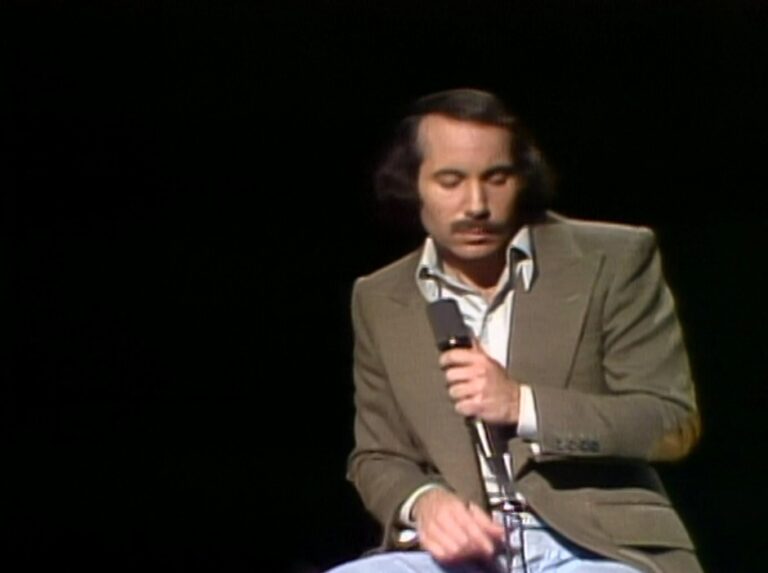
Being the host did not stop Simon from taking the stage to perform. After opening the night with the title track from his new album, Simon joined Garfunkel on stage to perform three songs. This historic reunion was only the second time the duo had performed together since their breakup five years earlier. The crowd recognized the impact of this performance, cheering and clapping to the point where nothing else could be heard at the beginning of the performance. When the roaring faded however, the tension between the duo was thick enough to be cut with a knife.
Before anything else, Simon turned and said “So Artie, you’ve come crawling back,” which prompted more laughter. In response, Garfunkel was quiet and only thanked Simon for inviting him to “his show.” When the music started, however, you could hardly tell there was any tension between the two. They immediately began a rendition of “The Boxer,” propelled by only vocals and Simon’s acoustic guitar.
As soon as this spirited performance, the awkwardness returns with Garfunkel dryly stating “two part harmony. It’s the greatest.” Then, again, as if nothing happened, they jumped straight into “Scarborough Fair,” performing as one well-oiled folk machine. This dichotomy between their awkward banter and cohesive performances provides an interesting look into Simon & Garfunkel that fans could not really see elsewhere.
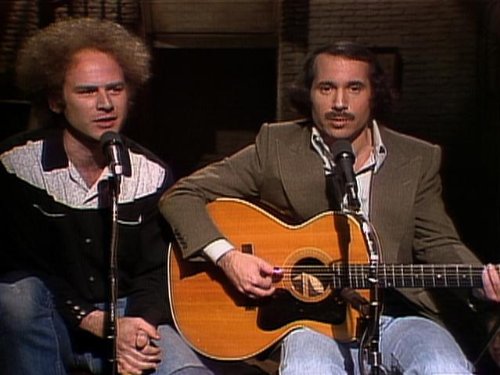
To cap off their performance, Simon dropped his guitar, as the duo took the stage with a full band backing. Their final song “My Little Town” off Simon’s Still Crazy After All These Years was the duo’s only song recorded since their breakup. With the SNL band behind them, Simon and Garfunkel belted out an impressive rendition of the song before leaving the stage. In many ways, their whole performance acted as a post mortem on their partnership, traversing their greatest hits from different eras of their career. In that way, this track – their last track – acts as a fitting Bookend to the Simon and Garfunkel experiment.
The highlight of this performance is its improvisational quality. Between each song, Simon just suggested a tune, and started plucking away at his guitar strings. With no more than a second thought, they were able to compose themselves and perform vocal harmonies that sound just like the recorded versions.
Patti Smith (4/17/76)
Only six months after Simon and Garfunkel graced the SNL stage, the show would make history again. This time, Lorne Michaels invited the New York-based Patti Smith group to perform. This performance marked the first appearance of Punk Rock on television, helping to propel the genre into the public eye.
By April 1976, Punk Rock was still in its infancy. Bubbling up out of Manhattan’s CBGB club, bands began to infuse 50s rock with a new speed and angst to mirror the disorder of the city around them. Patti Smith became the first member of this scene to release an LP: 1975’s Horses. By the time of her performance, she was alone in this field – her colleagues the Ramones wouldn’t release their debut until the next week. So in many ways, Smith not only sang for herself, but on behalf of all punk rock during her SNL performance.
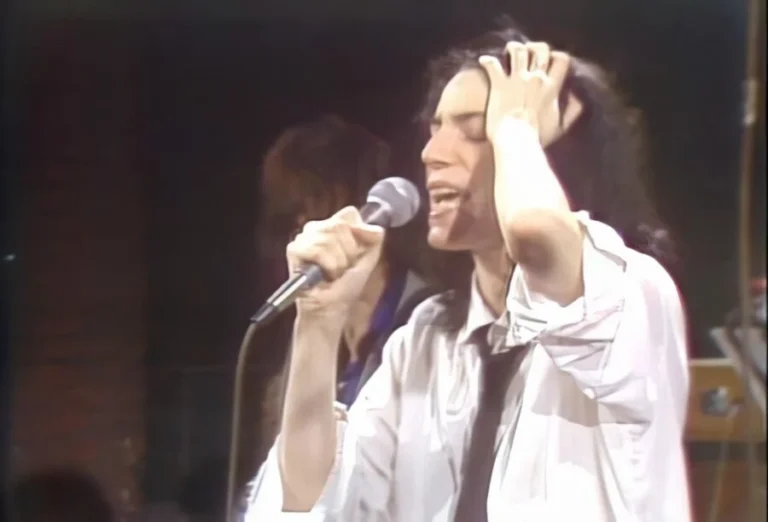
Smith’s punk ethos stood in stark contrast to the episode’s host Ron Nessen – Gerald Ford’s White House Press Secretary. Introduced to the audience by the president himself, Nessen was the epitome of the establishment. His dry speech and stunted attempts at humor were befitting of the Republican White House at the time – a frequent target of SNL’s attacks.
Nessen’s presence made the Patti Smith Group’s performance even more impactful. As members of the underground, much of the audience had no clue what to expect from their performance. Following Nessen’s introduction of the group, there was a noticeable before any applause. By the end of their first song, however, there was no doubt that Patti Smith was a star. The group began with a cover of Van Morrison’s 1964 song “Gloria.” Starting with solo piano, amplified guitars joined as the tempo gradually increased. Within the blink of an eye, the song erupted into an uptempo punk number – the first of its kind on any TV broadcast.
As the band hammered away at their instruments, Smith bounced and thrusted around the stage while belting out the vocals “G-L-O-R-I-A.” By the end of the track, it was clear that the Patti Smith group was making history, with the once-hesitant audience immediately applauding the performance. Smith capped off the performance by saying “Happy Easter CBGB,” giving a nod to her punk home. This shoutout helped introduce the now-legendary CBGB and punk as a whole to countless viewers across not only New York, but the whole country.
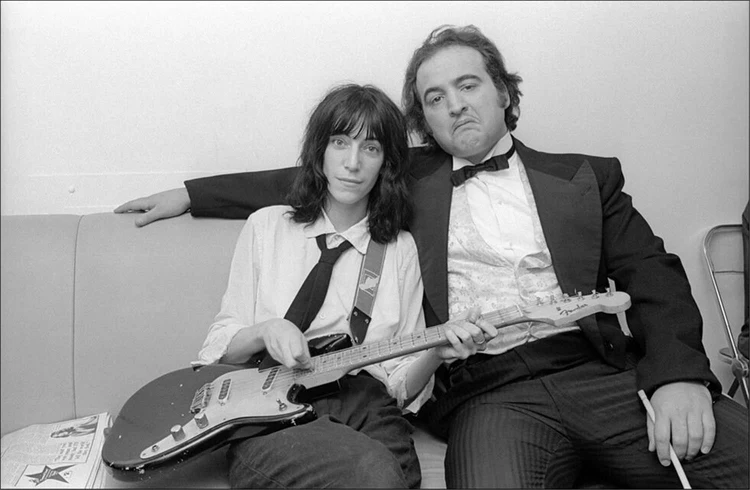
Following a number of skits, the band returned to perform another amped-up sixties classic – The Who’s “My Generation.” The fairly conventional cover quickly devolves into harsh guitar noise under Smith’s screeching vocals. As the performance ended, Smith made a statement calling out network censorship, barely heard over her guitar’s feedback and the roaring audience. By the end of this performance, Smith had become a staple of SNL as well – with Gilda Radner regularly spoofing the singer with her punk character “Candy Slice.”
This performance highlights an interesting snapshot in time. One where both SNL and Punk Rock were part of the underground, coexisting in the same circles. At the same time this episode represents a turning point in American culture as a whole. On one hand is the stale representative of the increasingly-unpopular conservative President Ford. On the other hand is a new generation of musicians turning the staples of the past upside down to make something completely new.
The Band (10/30/76)
The third of these great SNL performances was a legendary set by The Band. In late October 1976, the legendary Canadian folk band took the stage at 30 Rock. Invited by their fellow Canadian and SNL showrunner Lorne Michaels, The Band performed four songs that would go down in history.
The secret to this performance’s legendary status is timing, timing, timing. The Band’s performance sat in the shadow of two looming events. The first was The Band’s Last Waltz concert in San Francisco on November 25th. Billed as their farewell show, The Band did not pull any punches. At the epic performance, they took the stage alongside legends ranging from Joni Mitchell to Eric Clapton. In many ways, this SNL appearance was a practice run for their Last Waltz, taking the audience through their storied career.
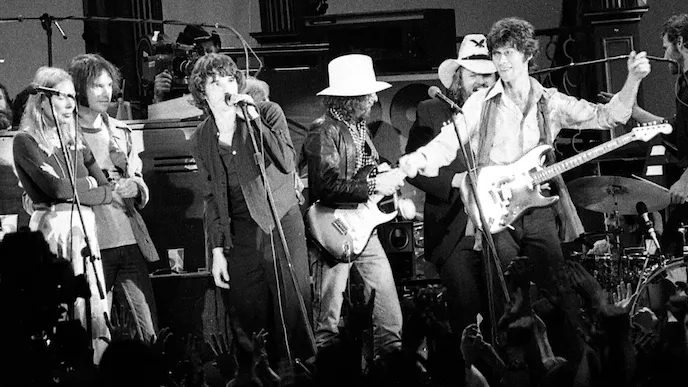
The second event looming over the performance was the 1976 Presidential election between Gerald Ford and Jimmy Carter. The politically-minded Lorne Michaels was no fan of incumbent Republican President Ford to say the least, frequently parodying him on SNL. As this October 30th show was the last airing before the election, Michaels wanted to remind audiences what was at stake through both the show’s skits and performances.
The Band’s SNL set did not start off politically. Rather, they took audiences on a journey through their discography with three classic songs. Without hesitation, The Band launched into “Life is a Carnival,” with a funky rhythm section and soulful horns propelling the song forward. This opener gave the SNL audience a taste of their musical chops through fiery guitar and organ solos.
The next song “The Night They Drove Old Dixie Down” saw The Band look back to their 1969 self-titled album. Jumping right into the song, drummer Levon Helm took over with his rich vocals. What stands out about this performance is The Band’s complete lack of stage presence. The members stand almost completely still while laying down the track. But it doesn’t matter one bit, as their musical talents are so immense that they were able to move the audience nonetheless.

The Band closed this first set with the title track from 1970’s Stage Fright. Keyboardist Garth Hudson took center stage during this piece. As he erupts into a fiery keyboard solo, an overhead camera captured his shredding in real time. This track would have been an otherwise perfect end to their set, but as it turns out The Band had one last number in them.
To close out the show, The Band reappeared to perform a rendition of Hoagy Carmichael’s “Georgia on My Mind.” As part of Lorne Michaels’ political ethos, the track was intended as a final reminder for who to vote for. In this case, it referenced then-Georgia governor and Democratic candidate Jimmy Carter. While this track was noticeably slower than their previous songs, they are able to imbue it with unbelievable amounts of soul. As it turns out this soulful tune managed to sway audiences watching at home. As drummer Levon Helm recalled, they played “and a few days after that, Jimmy Carter was elected president.”
Paul Simon & George Harrison (11/20/76)
In November 1976, Paul Simon returned for his second appearance as SNL host. Starting off the show, he immediately sought to parody his first stint on the program with another performance of “Still Crazy After All These Years.” The only difference with this performance was that Simon was in a giant turkey costume – it was the Thanksgiving show after all. After cutting the performance short, Simon joked about not wanting to be made a fool of.
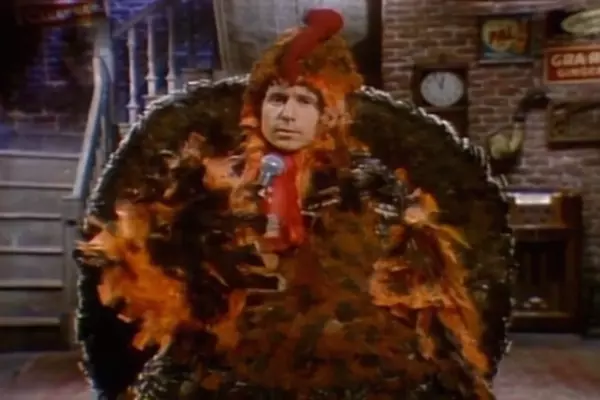
Simon had no need to worry about being a fool, because his performance that night proved his folk bona fides. The performance came as part of a collaboration with musical guest and Beatles guitarist George Harrison. Prior to this episode’s filming, Lorne Michaels had an idea for a publicity stunt. He offered $3,000 for a Beatles reunion on SNL, hoping to capitalize on the remaining bits of Beatlemania. To his surprise, George Harrison showed up and tried to collect the money as a joke. Michaels obviously said “no” as you can’t have a Beatles reunion with only one Beatle.
Despite this, Harrison continued to play four songs that night, alongside Simon. The highlight of the night took the form of a collaboration with Paul Simon and George Harrison. Each of these artists had a claim as the greatest songwriter on their respective side of the Atlantic, so having them perform together was a greater crossover than anyone could have hoped for. They began their set with the Beatles’ classic “Here Comes the Sun.” With Harrison leading and Simon providing harmonies, the duo performed a great acoustic rendition of the track. The duo then fittingly followed this up with a rendition of a Simon & Garfunkel classic “Homeward Bound.”
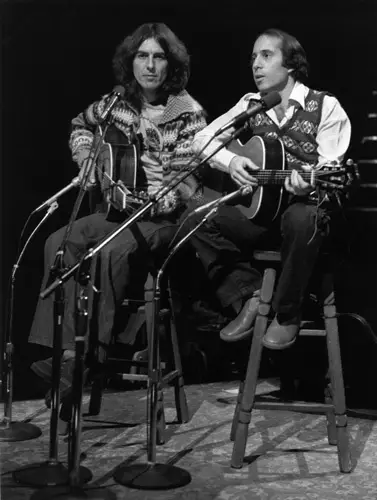
Throughout the broadcast, Simon performed three solo tracks. He began with the classic “50 Ways to Leave Your Lover,” off of his latest release. Simon then worked his way backwards through the seventies, with “Something So Right” off 1973’s One Trick Pony. Finally, he ended the night with a solo rendition of “Bridge Over Troubled Water,” originally recorded with Art Garfunkel. This version, featuring only Simon’s vocals and acoustic guitar provides a much more stripped down reimagining of the original song.
Turning the attention back to the night’s star – George Harrison – he highlighted two tracks from his new album Thirty Three & ⅓. I would have said performed … except that in a strange turn, Harrison opted to splice in music videos for his tracks “Crackerbox Palace” and “This Song.” This move really highlights SNL’s roots in the 1970s variety show trend, something that is lost to audiences today. Prior to the videos’ screenings, Dan Aykroyd introduced them as “films.” This performance, although unconventional, reflects the variety of early SNL, combining music, film, and comedy into a new revolutionary form of television.
Ray Charles (11/12/77)
Following Paul Simon’s lead, Ray Charles took up the double duties as host and musical guest on November 12th, 1977. This appearance allowed Charles to illustrate that he was truly a 20th century Renaissance man. Not only did he have serious chops as a vocalist and pianist, but his comedy rivaled many of SNL’s cast members. Starting off the show, Charles revealed his reason for hosting. “When the people from Saturday Night first asked me to host this show, of course I said absolutely not. I knew the show was tasteless and offensive and there was no way I was gonna let 30 years of my career go down the drain. I might be blind but I’m certainly not stupid.”
The rest of the night proved that Charles’ decision to host was anything but stupid. His performances brought the energy and sound of his 1950s recordings straight to the 30 Rock stage. Charles was very particular when it came to faithfully recreating the sound of his records. As a result, he opted not to use SNL’s in-house band, bringing his own musicians with him. Among the musicians was his original 1950s horn section and the Raelettes to back him up.
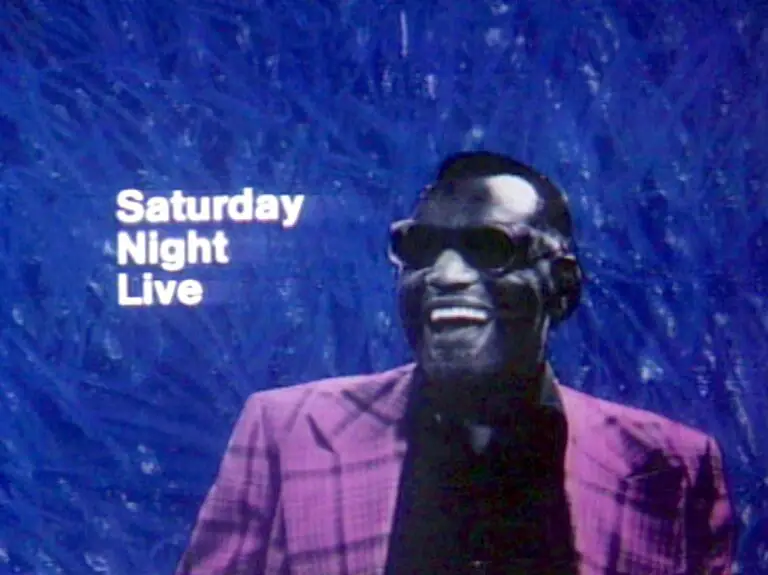
This attention to detail proved its worth with their first song “I Can See Clearly Now.” Driven by Charles’ soulful vocals, this Johnny Nash cover easily outshines the original. Throughout the track, layers of joyous gospel vocals backed up Charles’ singing. As the song progressed and the horn section joined in, Charles’ vision became clear. Each performer in Charles’ ensemble played perfectly as one well-oiled machine. Following the performance, Charles illustrated his comedic chops once again, faking out the audience with the intro to “Georgia on My Mind” – a nod to then-president Jimmy Carter.
To follow up this amazing cover, Charles then performed an original – “What’d I Say.” For this number, Charles moved over to the electric keyboard and ripped out the song’s iconic riff. While this song started off much more restrained than its predecessor, it quickly grew in intensity. The highlight of the song is the vocalized call and response between Charles and the Raelettes – an undeniably catchy piece of music.
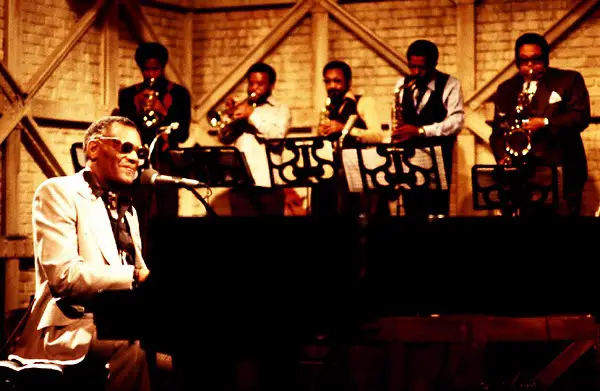
After “What’d I Say,” Charles performed two songs highlighting his range as a musician. First comes “I Believe to My Soul,” a much bluesier number than before. This slower track highlighted Charles’ rich vocals, highlighted by the Raelettes’ minor-key backing. The next track, a rendition of “Hit the Road Jack,” goes into full-on jazz. Each section of Charles’ horn ensemble gets the chance to play an extended solo, providing a much different aura than their previous tracks.
The pinnacle of Ray Charles’ performance was his closing track “Oh, What a Beautiful Mornin’.” The song’s slow piano intro quickly evolved into a lilty pop tune propelled by organ and Charles’ vocals. As the horn section joins in, the song’s full colors shine, with the listener being able to picture themselves in the lovely morning Charles sings about. Throughout the performance, Charles swayed in his seat and stomped along to the beat so powerfully he nearly pushed his piano bench over. With this piece, Charles used a beautiful mornin’ to send off a beautiful night.
Elvis Costello (12/17/77)
Elvis Costello came as the second of many punk performances on SNL. During his set, Costello embodied punk more than anybody else, and took a direct stand against Lorne Michaels. This was a decision that cost Costello dearly and destroyed any relationship he had with SNL.
Originally, Michaels had no plan for Costello to perform on SNL. Seeing the shifting musical landscape in England, he wanted to get ahead of the curve and invite up-and-coming punk rockers: the Sex Pistols. As it turned out, the Pistols’ reputation that caught Michaels’ eye also ruined any chances of them performing. Not only were network executives worried about what provocative actions the band would take, but they were also in trouble with the law. The members’ history of drug and assault-related offenses had reached the US embassy in London. By the time they had applied for visas, the embassy replied with an unflinching “no.”
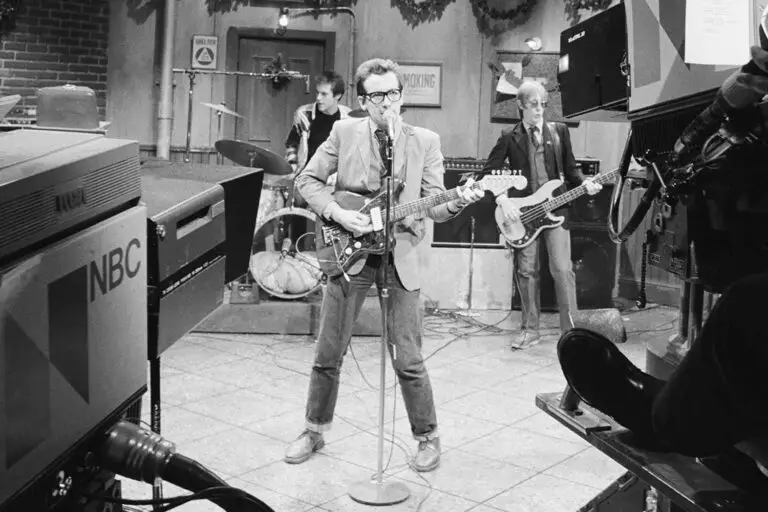
This legal snafu made Michaels nervous to say the least. He scrambled to find another punk act to fill in. First, he turned to New York’s Ramones, who were not receptive to his offer. Johnny Ramone simply replied “We don’t substitute for nobody.” This left one option for Michaels: Elvis Costello. Costello and the Attractions were in New York as part of an American tour and would still provide some degree of punk credos.
Today, it’s funny to think of Costello as being transgressive or controversial by any means. However, in 1977, he stood as part of a “New wave” of British acts building on punk. While his sound deviated from traditional punk, his attitude did not. His set started normally enough, with a performance of ‘Watching the Detectives.” The track combined punk with a reggae beat and staccato organ stabs, creating a sound unique to Costello.
The highlight of Costello’s performance came with his second track, “Less Than Zero.” Prior to his appearance, Costello’s record label pushed him to perform the track on SNL. Costello had a few qualms with the idea however. Firstly, the song discussed British fascist leader Oswald Mosely, who was widely unknown to American audiences. Secondly, it was too low key. Costello knew he had to woo audiences, and wanted to play a song with real power behind it.

That’s why not even five seconds into the song, Costello abruptly yelled “Stop!” Turning to the Attractions, he waved his hands and got them to go quiet. He then said to the audience “I’m sorry, Ladies and Gentlemen, there’s no reason to do this song here.” Then, without hesitation, the band jumped into the then-unreleased “Radio, Radio.” The song, inspired by the BBC’s ban of the Sex Pistols, embodies the best aspects of punk. The anti-establishment track rallies against media censorship of bands – something that reminded Costello of how his label treated him. This performance is undoubtedly one of the greats of the 1970s, with the band bringing both an energy and refinement to the track. The audience also loved the track, applauding and cheering as soon as the band stopped.
Despite this success, Michaels was outraged. He took Costello’s choice to deviate from the setlist as a personal affront that threatened his authority on the show. As a result, Michaels banned Costello from SNL until 1989. It was only 12 years later that Costello returned as a solo act to perform his hit song “Veronica.”
Blues Brothers (4/22/78)
April 22nd, 1978 brought something completely new to SNL – an in-house musical act. For two years, comedians Dan Aykroyd and John Belushi had been cooking up a musical project, simply known as the Blues Brothers.
The inklings of the Blues Brothers began in 1976, with the sketch “Howard Shore and his All-Bee Band.” The duo took up the roles of Belushi on vocals and Aykroyd on harmonica. The only difference was that they were – as the name suggests – dressed as giant bees. Despite the one-off nature of this skit, the duo continued to pursue the blues. When guitarist Arlen Roth played the show in 1978, he taught the duo how to play Jackie Brenston’s “Rocket 88,” continuing down the blues pipeline.
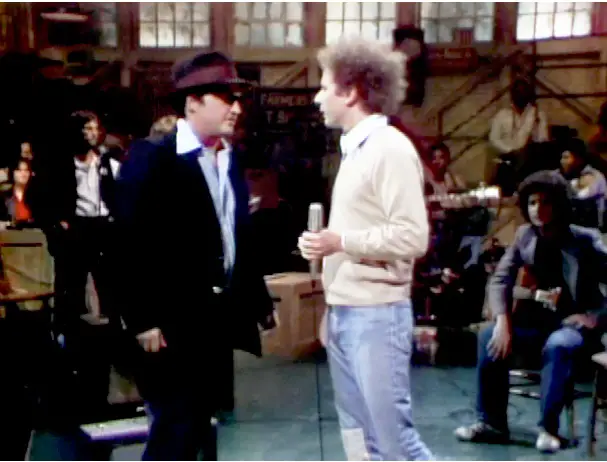
Soon, Aykroyd and Belushi had dubbed themselves “the Blues Brothers,” donning sharp black suits, shades, and fedoras. Their appearance on SNL in 1978 helped to further cement their characters and introduce them to American audiences. The skit starts off with SNL bandleader Paul Shaffer taking up the role of the band’s agent, introducing them to viewers. He calls them “a new blues act that had been playing in a small, funky club on Chicago’s South Side.” Poking fun at the duo, he points out “they are no longer an authentic blues act, but have managed to become a viable commercial product.”
And just like that, audiences came to know “Joliet” Jake and Elwood Blues. Standing on stage in their matching outfits, they jumped into their first track “Hey Bartender.” If anybody had doubts about the comedians’ blues chops, this performance proved them wrong. A bluesy rhythm section and soulful horns propelled the song forward with an unmatchable groove. The highlight of the song, however, has to be Jake’s vocals. Throughout the song, Jake absolutely belted out his lines, while spinning in circles. Elwood, while never speaking, was silent by no means, busting out a fiery harmonica solo midway through the track.

Following this blowout performance, the band gave way to a number of skits, including Steve Martin’s timeless “Funky Tut.” Towards the end of the show, the Brothers returned to perform “I Don’t Know.” The track started off with Elwood’s bluesy harmonica riffage, which immediately gets the audience clapping along. As the song progressed, the backing horns and organ mirrored Elwood’s lead. Elwood then ripped out another harmonica solo, with Jake clearing the stage to perform somersaults. Halfway into the song, Jake went into a hilarious spoken word interlude, filled with a number of cigarette-themed double entendres.
Although this performance wasn’t the beginning of the Blues Brothers, it was certainly their introduction to countless Americans. After their set, it was clear that “Joliet” Jake and Elwood Blues had become staples of SNL. With their hit movie only 2 years later, the Blues Brothers proved themselves to be the “viable commercial product” their agent had bragged about.
The Rolling Stones (10/7/78)
For SNL’s Season Four premier, Lorne Michaels booked one of the greatest bands in rock history: The Rolling Stones. Lorne believed that this would be a victory lap, proving that despite everything going against it, SNL was a bonafide cultural phenomenon. However, as it turns out, nothing can be that easy when it comes to planning an SNL episode.
First off, NBC had concerns due to the Rolling Stones’ reputation. Execs feared that Rolling Stones fans might even try to storm 30 Rock to get a glimpse at the rockers. This in reality was nothing compared to the danger the band itself posed. On top of their reputation as all-time performers, the band also had a reputation for being all-time partiers. This, combined with SNL’s very own John Belushi, was a recipe for disaster.
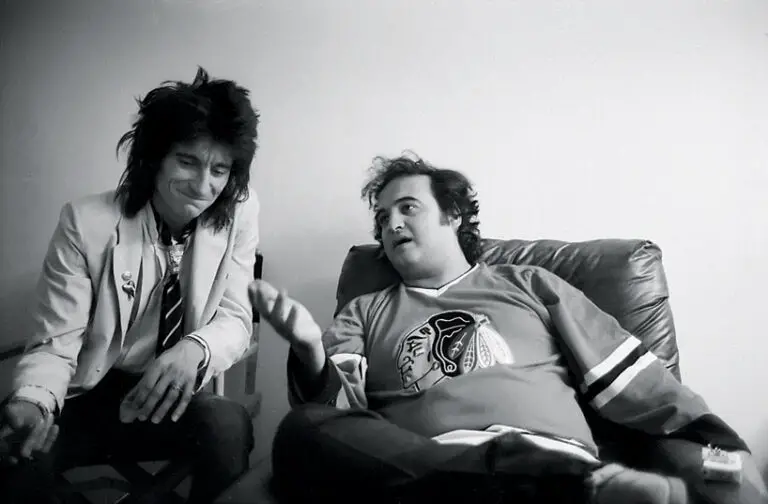
While rehearsals started out well, they quickly devolved into chaos. As the show date approached, the band’s behaviors started to concern the cast. The Stones were openly drinking vodka and snorting cocaine during rehearsals, and were spending more time with Belushi at late-night parties. So when the fateful Saturday night finally arrived, no one had any idea what to expect.
On top of hosting the show, the Stones took the stage to perform a 13 minute set made of songs from their new album Some Girls. From the start of their first song “Beast of Burden,” there was an immediately evident problem. Days of partying and drinking had left Mick Jagger’s voice absolutely shot. For any lesser band, this would have been the nail in the coffin, but somehow it did not seem to matter. Despite his raspy vocals, Jagger’s stage presence was unmatchable. He danced around the stage with a cigarette all while wearing a bright orange “beast” shirt and a Scottish tam hat – a look that was very 70s to say the least.
After finishing their classic opener, the band shifted to “Respectable.” This more punk-influenced track saw Jagger join Ronnie Wood and Keith Richards on guitar. Most people would assume having to play guitar would constrain some of Jagger’s on-stage antics, but they would be wrong. As Ronnie Wood shredded out the song’s solo, Mick Jagger went right up to him and licked his face. As Wood recalled, ““I had my eyes closed for a few seconds and suddenly I felt this wet, warm thing slurping on my face. It was Mick’s tongue. I tried to kick him, but he was too fast.”
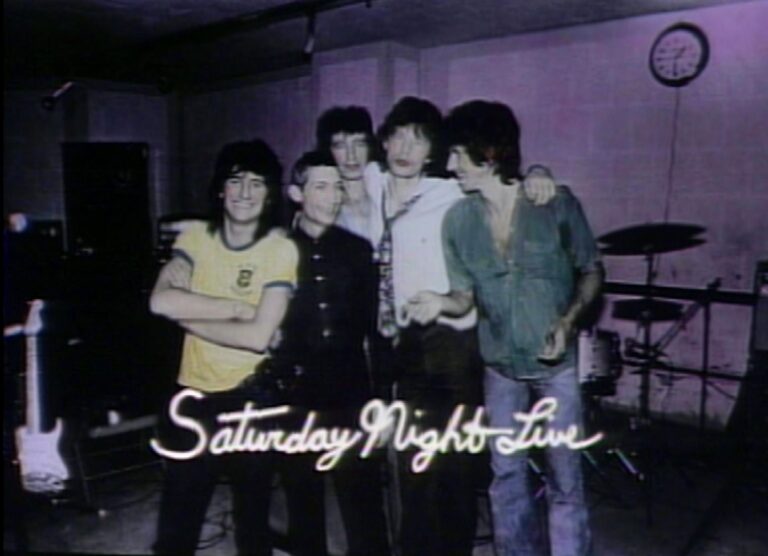
If face licking and punk riffs weren’t enough, the Stones felt the need to one up their own chaos on their final song “Shattered.” Throughout the song, Mick Jagger ran around the stage, while not losing a breath. While it started off pretty standard, things began to go downhill during Ronnie Wood’s solo. Jagger must have had it out for his guitarist that night, because he took off his blazer and began hitting Wood with it, which somehow did not seem to phase him. For the remainder of the song, Jagger continues to sing along, while ripping apart his shirt and gyrating towards the camera. These moves reportedly scared NBC censors in the moment, who feared that Jagger would continue to remove his clothes.
This performance remains a contentious part of SNL’s music history, with audiences still debating over its status. The in-studio audience on October 7th, 1978 appeared to love the act, applauding each number. However, when viewing the recording afterwards, Jagger admitted “Maybe this wasn’t such a good show.” Still, whether audiences loved or hated the performance, they surely remembered it.
Devo (10/14/78)
The next great performance came only one week after the Rolling Stones’ headlining gig. Despite being only the next episode, Devo was musically as far from the Stones as you could get at the time. Although Devo are now known as MTV New Wave stars, in 1978, they were virtually unknown. That’s why when their manager reached out to Lorne Michaels pitching the band for SNL, he immediately said “no.” To Michaels, Devo was a wacky band not ready for the limelight. Only after a series of negotiations, where their manager promised a future appearance by Neil Young, was Devo allowed to take the stage.
From the second they took the stage, it was clear that Devo was unlike anybody else to play SNL. Their first number was a cover of The Rolling Stones’ “Satisfaction.” It might just be coincidence that their biggest song was a cover from the prior week’s host, but it almost seemed like a fated changing of the guard.
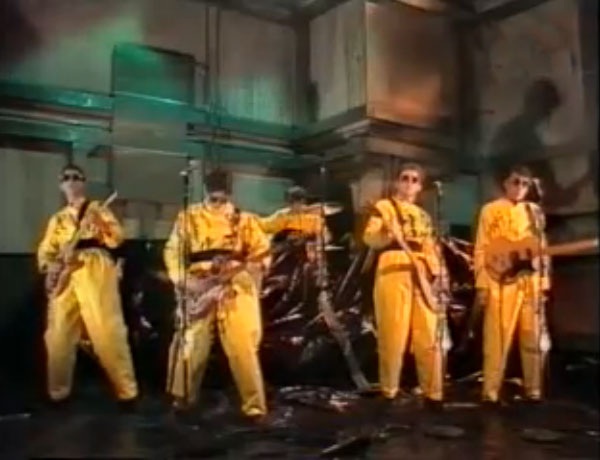
Whereas the Rolling Stones performed in colorful outfits and danced around the stage, Devo was unnaturally stiff. All the members emerged wearing matching yellow jumpsuits and square sunglasses. Not only did they look like robots, but they also moved like them, with jagged and jittery movements choreographed throughout their set. In terms of the song itself, “Satisfaction” was nearly unrecognizable. The original song’s fuzzed out guitars were replaced by syncopated, almost funky lines. In the place of Mick Jagger’s growl was Mark Mothersbaugh’s off-kilter yelps. If the Rolling Stones were veterans of the past, Devo came straight from the future.
What came next from Devo was something unique: a self-made intro skit introducing their next number. The video is surreal to say the least. It follows the band’s mascot Booji Boy, as he carries papers to a US general. The general declares that “every man, woman, and mutant on this planet shall know the truth about de-evolution.” This video points to Devo’s origins as an avant-garde group – something lost on people who have only heard “Whip It.”
Following the Kent State Massacre, the members of Devo were convinced that humanity was devolving, rather than evolving – hence the name Devo (short for De-evolution). They used their robotic movements and off-kilter music as an art piece to show what people would look like when a fully devolved herd mentality took over society. Following their intro skit which introduced these ideas, the band played “Jocko Homo.”
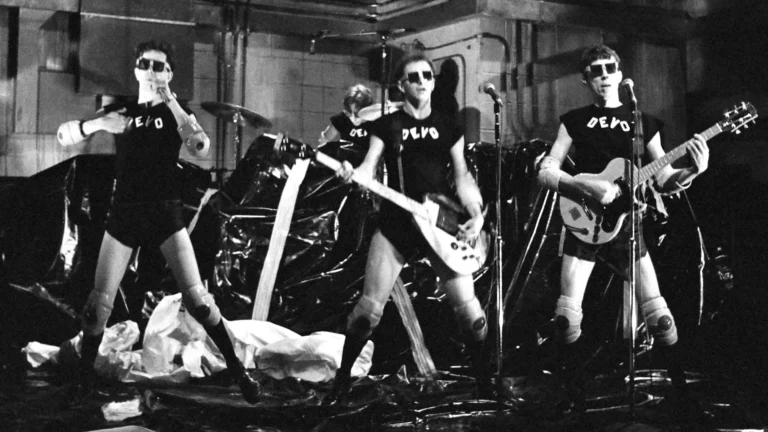
If “Satisfaction” was otherworldly, then “Jocko Homo” came from another dimension. As the band played, green lights illuminated the SNL stage, making the band look like they were inside a UFO. Whereas guitars drove “Satisfaction,” the keyboard takes center stage in this number, with its odd timbre sticking out like a sore thumb. Throughout the whole song, Mark Mothersbaugh and the other members repeat a monotone call and response, “Are we not men? We are Devo.”
Halfway through the song, Mothersbaugh’s vocals cut out and the tempo picked up. As soon as this happened, the band members all began to tear apart their jumpsuits to reveal what can only be described as matching Devo-themed roller derby outfits. This moment demonstrated to audiences Devo’s theatrical weirdness that later rocketed them to fame in the 80s. As the band ended their set and Morthersbaugh yelled “Beaming down from the future,” the audience went wild.
This performance was the world’s introduction to Devo, and helped to push their career to heights they could not have imagined before. As bassist Jerry Casale recalled, “We went from playing in front of 200, 300 people a night to 3,000, 5,000 people a night.” All it would take was MTV to make these up-and-comers stars
David Bowie (2/15/79)
The final great act of the 1970s came from the legendary David Bowie. With actor Martin Sheen hosting the episode, Bowie was invited to play three songs throughout. All three of the performances that night illustrated that nobody could put on a show quite like David Bowie. Whether it was subverting gender stereotypes, messing with special effects, or just being odd, Bowie brought his trademark energy to the show that night.
To start off the night, Bowie performed an older track, “The Man Who Sold the World.” As the spotlights illuminated the stage, Bowie appeared wearing a ridiculously exaggerated plastic outfit. With a long skirt, jagged corset top, and comically large bowtie, Bowie was left almost completely immobile. This left his backup singers with the duty of carrying him to the mic. In terms of backup singers, Bowie enlisted German countertenor Klaus Nomi and cabaret singer Joey Arias. With dyed black and pink hair, monotone uniforms and ashen faces, they added to the performance’s otherworldly aura. Throughout the song, their vocals accented Bowie’s, making an otherwise standard rock track sound near-operatic.

After a number of skits, including a parody of Sheen’s Apocalypse Now, Bowie returned to the stage. This time, Bowie played “TVC15” from 1976’s Station to Station. The more funk and soul influenced track also saw Bowie take up a more down to Earth fashion style. That outfit included what can only be described as a blue Mao suit, heels, and a long skirt. This left Bowie much more mobile to dance along to the upbeat track. While being more conventional, the performance was still heavily rooted in the avant-garde. Throughout the performance, a fake pink poodle sat next to Bowie. At one point the camera slowly zoomed into the poodle’s mouth revealing a screen also showing the performance creating an almost inception-like quality.
The final track of the night was the live debut of “Boys Keep Swinging” from Bowie’s latest album Lodger. One might ask themself, “how can Bowie one up these already insane performances?” Well the answer is simple: He green screened a puppet body onto himself. Throughout the performance, Bowie operated a small pink puppet, using the studio’s special effects to superimpose it over himself for audiences at home. The effects by today’s standards look dated to say the least, and even at the time they must have looked campy. Despite this, watching Bowie’s puppet body flail across the stage is an undeniably funny experience.
The post 50 Years of Performance: The Best SNL Acts of the 1970s appeared first on NYS Music.








